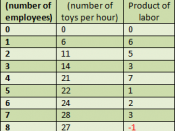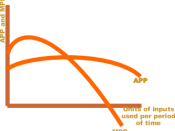In the background to supply, we notice about the terms "total product", "marginal product" and "average product". These three figures are the foundation upon which the analysis of short-run production for a firm is analyzed.
Total product is the total quantity of output produced by a firm for a given quantity of inputs. The usual framework is to analyze total product when in a variable input (labor) changes, for a given amount of a fixed input (capital).
Diagram 1
In diagram 1, as the curve shows, the more labor hours you used, the more output of product before the point Tmax. After the curve go through the point Tmax, the more labor hours the less output. When we constructing this curve, it is assumed that total product changes from changes in the quantity of a variable input like labor, while we hold one or more other inputs, like capital, fixed.
(Q= output, L=input)In short run the firm may be able to vary the amount of labor, but can not change capital.
Marginal product is the change in quantity when one additional unit of input used, keeping all other inputs unchanged. Marginal product usually abbreviated MP, is found by dividing the change in total product by the change in the variable inputs.
MP= DQ/DL (holding K constant)
Diagram 2
In diagram 2, the marginal product curve is related to the total product curve in diagram 1. If the total product curve has a positive slope (upward sloping) then marginal product is positive. If the total product curve has a negative slope (downward sloping), then marginal product is negative. If the total product curve has a zero slope (horizontal), then marginal product is zero. Moreover, if the total product curve has a positive and increasingly steeper slope, then the marginal...


